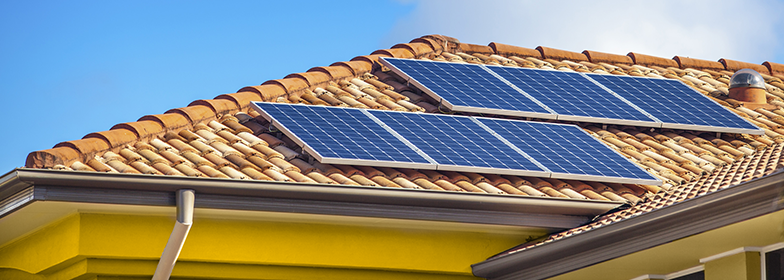
Energy-efficient homes
From recycling bottles and cans to hanging clothes to dry, there are many ways to make the world a little greener every day. Simple steps like these can make a difference in building a more sustainable future. Are you looking for a significant way to reduce your environmental impact? Conserving energy used in your home and investing in renewable energy solutions is a great place to start.
While there are different types of energy-efficient homes, you don’t have to build a new home to go green. Energy-efficient upgrades and improvements can decrease energy use in any home. Even better, budgeting to reduce your carbon footprint just got easier. With Guild Mortgage, you have the option of financing energy-efficient appliances, smart upgrades and solar panels with an energy-efficient mortgage program .
Types of energy-efficient homes
If you’re in the market for a new home or renovating an existing home, there are a few different types of energy-efficient homes to choose from. Here are three that minimize reliance on fossil fuels through technology, design and manufacturing.
- Ultra-efficient homes
This type of home design combines less energy use with renewable energy sources. Ultra-efficiency is gained when a home generates as much energy as it uses. “The intent is to reduce home energy use as cost-effectively as possible, and then meet the reduced load with on-site renewable energy systems,” explains the U.S. Department of Energy (DOE).
- Passive homes
A passive home is a type of ultra-efficient home built to the rigorous construction standards of the Passive House Institute (PHI). Some of the qualities of these homes outlined by PHI include:
- Space heating and cooling-related energy savings of up to 90% compared with typical buildings
- Efficient use of the sun and internal heat sources, rendering conventional heating systems unnecessary
- Special windows to keep the desired warmth in the house or unwanted heat out
- A ventilation system that supplies constant fresh air
- Efficient manufactured homes
Manufactured homes use materials similar to site-built homes but are manufactured in the builder’s warehouse then assembled onsite. Just like site-built homes, they can be designed with options to save energy with custom amenities, including energy-efficient appliances. In addition, because they’re constructed in a controlled environment, these homes can be made much more efficiently, lowering the cost of construction and improving affordability for new homebuyers. According to David Battany, Executive Vice President of Capital Markets at Guild Mortgage, “The use of robotics helps speed the building process without sacrificing quality. The waste from construction for manufactured homes can be less than half the waste of a site-built home.”
5 energy-efficient home features
If you’re aiming for a comfortable, efficient and resilient home, these five improvements can help you go green.
- 1. Insulate your windows
Did you know that up to 30% of residential heating and cooling energy use is due to heat loss and heat gain through windows? The DOE recommends two options to save energy use. First, you can choose to update your existing windows by using weatherstripping, adding window treatments or installing storm windows and exterior shades. Or, replace your windows with the most efficient windows for your needs.
- 2. Purchase highly efficient appliances
If you’re looking to save on your electric bill, it can be beneficial to install highly efficient appliances. The DOE recommends shopping for ENERGY STAR-qualified products because they “exceed the federal minimum standards for efficiency and quality — sometimes significantly.” While you may pay more upfront, the cost of operating these products is less than their non-energy efficient equivalents.
- 3. Automate your home with a smart thermostat
Smart thermostats are not just beneficial because they enable control of your heating and cooling system from your smartphone. They can also learn your daily habits and cool or heat your home only as much as needed. By using a smart thermostat that meets ENERGY STAR certification, you may save approximately 8% on your heating and cooling bills.
- 4. Invest in solar
Commonly, more than half of a home’s energy is used to heat it in the winter and cool it down in the summer. While there are installation and maintenance costs when investing in solar, by using the sun’s energy, you can lower your carbon footprint along with your electric bill. Recent Zillow research found that installing solar panels can also potentially increase your home’s value by 4.1% more than comparable homes with no solar.
- 5. Add more insulation
Insulation is a sound investment to reduce heating and cooling costs while improving comfort— and it doesn’t just belong in an attic. To make your home more energy-efficient, you may want to take a top-down approach, insulating from the roof down to the foundation.
Financing an energy-efficient home
Did you know that you can also go green with your mortgage? Before building a new home, buying an older home or refinancing your current home, you may want to consider the benefits of an energy-efficient mortgage. These loans can help you reduce utility costs and monthly expenses. With housing inventory at an all-time low, energy-efficient mortgages provide an opportunity to buy and make improvements to any home.
The above information is for educational purposes only. All information, loan programs and interest rates are subject to change without notice. All loans subject to underwriter approval. Terms and conditions apply. Always consult an accountant or tax advisor for full eligibility requirements on tax deduction.
